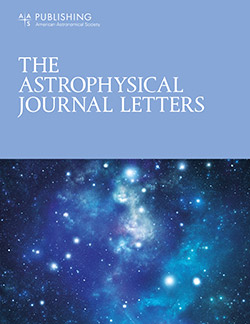利用WASP-80b近红外日侧光谱探测气溶胶反射
IF 8.8
1区 物理与天体物理
Q1 ASTRONOMY & ASTROPHYSICS
引用次数: 0
摘要
气溶胶的存在与全球能量收支和行星大气组成密切相关。它们反射入射光的能力阻止了能量沉积到大气中,它们塑造了系外行星的光谱。我们利用哈勃太空望远镜上的宽视场相机3 (WFC3)观测了WASP-80b的5次近红外二次日食,以提供大气气溶胶存在和性质的约束条件。我们探测到WASP-80b的宽带日食深度为34±10 ppm。我们探测到的行星通量比仅从热发射中预期的要高,为1.6 σ,这暗示在这颗行星的日面存在反射气溶胶,表明a g <的几何反照率;在3 σ处为0.33。我们将WFC3的数据与斯皮策的数据配对,并探索了有或没有气溶胶的多种大气模型来解释这一光谱。尽管与晴朗的日面大气一致,但我们发现近太阳金属丰度和日面云比雾霾更有轻微的偏好。我们排除了在3 σ下大于10−10.7 g cm−2 s−1的烟灰霾形成率和大于10−12.0 g cm−2 s−1的噻吩形成率。我们将同样的大气模型应用于之前发表的WFC3/斯皮策透射光谱,发现了微弱的雾霾形成。单一的烟灰霾形成率最适合同时适应昼侧光谱和透射光谱。然而,我们强调,没有任何模式能同时提供令人满意的两种光谱的卡方拟合,这表明大气气溶胶成分的纵向差异。本文章由计算机程序翻译,如有差异,请以英文原文为准。
Probing Reflection from Aerosols with the Near-infrared Dayside Spectrum of WASP-80b
Abstract The presence of aerosols is intimately linked to the global energy budget and the composition of a planet’s atmosphere. Their ability to reflect incoming light prevents energy from being deposited into the atmosphere, and they shape the spectra of exoplanets. We observed five near-infrared secondary eclipses of WASP-80b with the Wide Field Camera 3 (WFC3) aboard the Hubble Space Telescope to provide constraints on the presence and properties of atmospheric aerosols. We detect a broadband eclipse depth of 34 ± 10 ppm for WASP-80b. We detect a higher planetary flux than expected from thermal emission alone at 1.6 σ , which hints toward the presence of reflecting aerosols on this planet’s dayside, indicating a geometric albedo of A g < 0.33 at 3 σ . We paired the WFC3 data with Spitzer data and explored multiple atmospheric models with and without aerosols to interpret this spectrum. Albeit consistent with a clear dayside atmosphere, we found a slight preference for near-solar metallicities and for dayside clouds over hazes. We exclude soot haze formation rates higher than 10 −10.7 g cm −2 s −1 and tholin formation rates higher than 10 −12.0 g cm −2 s −1 at 3 σ . We applied the same atmospheric models to a previously published WFC3/Spitzer transmission spectrum for this planet and found weak haze formation. A single soot haze formation rate best fits both the dayside and the transmission spectra simultaneously. However, we emphasize that no models provide satisfactory fits in terms of the chi-square of both spectra simultaneously, indicating longitudinal dissimilarity in the atmosphere’s aerosol composition.
求助全文
通过发布文献求助,成功后即可免费获取论文全文。
去求助
来源期刊

Astrophysical Journal Letters
ASTRONOMY & ASTROPHYSICS-
CiteScore
14.10
自引率
6.30%
发文量
513
审稿时长
2-3 weeks
期刊介绍:
The Astrophysical Journal Letters (ApJL) is widely regarded as the foremost journal for swiftly disseminating groundbreaking astronomical research. It focuses on concise reports that highlight pivotal advancements in the field of astrophysics. By prioritizing timeliness and the generation of immediate interest among researchers, ApJL showcases articles featuring novel discoveries and critical findings that have a profound effect on the scientific community. Moreover, ApJL ensures that published articles are comprehensive in their scope, presenting context that can be readily comprehensible to scientists who may not possess expertise in the specific disciplines covered.
 求助内容:
求助内容: 应助结果提醒方式:
应助结果提醒方式:


